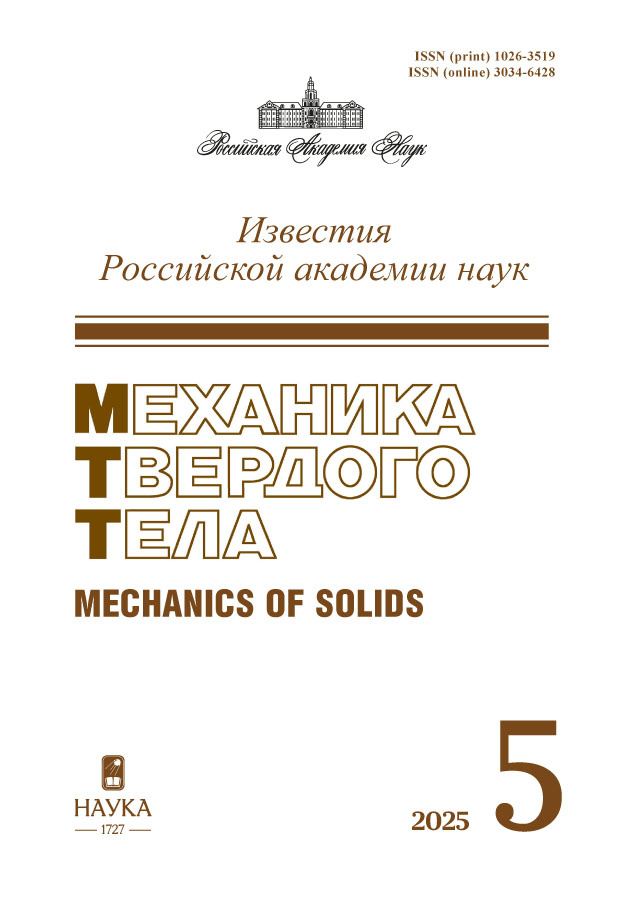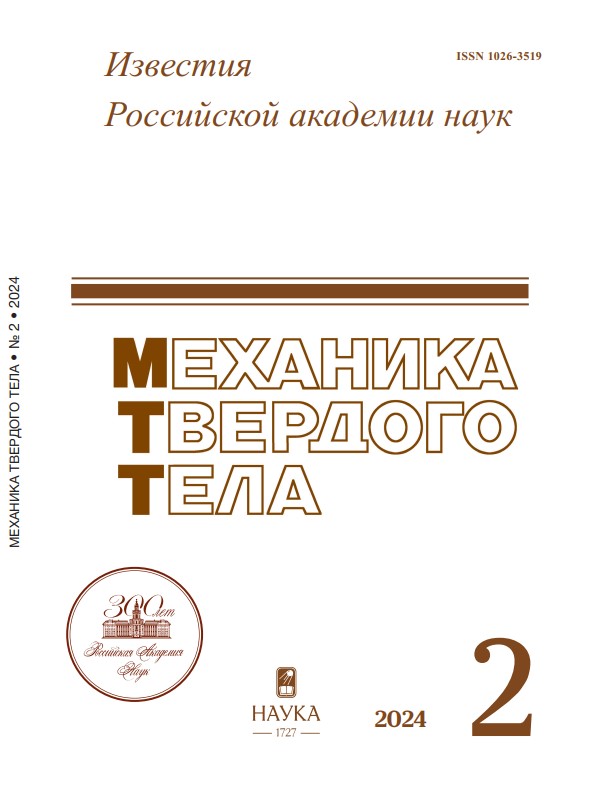Влияние циклической нагрузки на физико-механические свойства тонкопленочных мембранных структур
- Авторы: Дюжев Н.А.1, Гусев Е.Э.1, Портнова Е.О.1, Новикова О.В.1
-
Учреждения:
- Национальный исследовательский университет “МИЭТ”
- Выпуск: № 2 (2024)
- Страницы: 269-282
- Раздел: Статьи
- URL: https://ruspoj.com/1026-3519/article/view/673100
- DOI: https://doi.org/10.31857/S1026351924020131
- EDN: https://elibrary.ru/uvluoi
- ID: 673100
Цитировать
Полный текст
Аннотация
Впервые предложен, реализован и объяснен принцип модификации механических свойств тонкопленочных мембранных структур произвольной формы бесконтактным способом. Апробация идеи проведена на тонкопленочной мембране алюминия, сформированной магнетронным способом на кремниевой подложке. Внешнее воздействие осуществлялось посредством циклической нагрузки в виде сброса и подачи избыточного давления воздуха на мембрану. В результате многократных воздействий изменяются физические (размер зерен и шероховатость) и механические (внутренние механические напряжения и критическое избыточное давление) свойства материалов. Изменение величины остаточных механических напряжений в материале мембраны позволяет формировать поверхность с требуемым значением кривизны. В данной работе после циклической нагрузки давлением, равным половине от критического давления, выявлены следующие эффекты: прогиб мембраны в отсутствие внешнего воздействия увеличился более чем на порядок, структура перешла в пластический тип деформации, критическое давление разрыва уменьшилось на несколько десятков процентов. Применение данной методологии позволяет создавать новые материалы с уникальными механическими свойствами.
Ключевые слова
Полный текст
Об авторах
Н. А. Дюжев
Национальный исследовательский университет “МИЭТ”
Автор, ответственный за переписку.
Email: bubbledouble@mail.ru
Россия, Зеленоград, Москва
Е. Э. Гусев
Национальный исследовательский университет “МИЭТ”
Email: bubbledouble@mail.ru
Россия, Зеленоград, Москва
Е. О. Портнова
Национальный исследовательский университет “МИЭТ”
Email: bubbledouble@mail.ru
Россия, Зеленоград, Москва
О. В. Новикова
Национальный исследовательский университет “МИЭТ”
Email: bubbledouble@mail.ru
Россия, Зеленоград, Москва
Список литературы
- Zhang G.P, Schwaiger R., Volkert C.A., Kraft O. Effect of film thickness and grain size on fatigue-induced dislocation structures in Cu thin films // Philos. Mag. Lett. 2003. V. 83. № 8. P. 477–483. https://doi.org/10.1080/0950083031000151383
- Сalister W.D. Materials science and engineering: an introduction. 7th Edition. NY, 2007.
- Wang G., Liaw P. Fatigue and fracture behavior // Bulk metallic glasses. Boston: Springer, 2008. P. 169–203. https://doi.org/10.1007/978-0-387-48921-6_7
- Pan Q., et. al. History-independent cyclic response of nanotwinned metals // Nature. 2017. № 551. P. 214–217. https://doi.org/10.1038/nature24266
- Barr C.M., Duong T., Bufford D.C. et al. Autonomous healing of fatigue cracks via cold welding // Nature. 2023. № 620. P. 552–556. https://doi.org/10.1038/s41586-023-06223-0
- Заславский Б.В. Краткий курс сопротивления материалов. Учебник для авиационных специальностей вузов. М.: Машиностроение, 1986. 328 с.
- Dyuzhev N.A., Gusev E.E., Makhiboroda M.A. Study of the mechanical properties of thin-film membranes made of oxide and silicon nitride. // Mechanics of Solids. 2022. V. 57. № 5. P. 1044–1053.
- Перельмутер М.Н. Анализ трещиностойкости соединений материалов // Изв. РАН. МТТ. 2020. № 4. С. 96–114. https://doi.org/10.31857/S0572329922050063
- Бабешко В.А., Бабешко О.М., Евдокимова О.В. Трещины нового типа и модели некоторых наноматериалов // Изв. РАН. МТТ. 2020. № 5. С. 13–20. https://doi.org/10.31857/S0572329920050025
- Novak A.V., Novak V.R., Dedkova A.A., Gusev E.E. Dependence of mechanical stresses in silicon nitride films on the mode of plasma-enhanced chemical vapor deposition // Semiconductors. 2018. V. 52. P. 1953–1957. https://doi.org/10.1134/S1063782618150095
- Shikunov S.L., Kurlov V.N. SiC-based composite mterials obtained by siliconizing carbon matrices // Technical Physics. 2017. V. 62. P. 1869–1876. https://doi.org/10.1134/S1063784217120222
- Беспалов В.А. и др. Обзор методов исследования механических свойств тонких пленок // Моделирование систем и процессов. 2022. Т. 15. № 3. C. 110–128. https://doi.org/10.12737/2219-0767-2022-15-3-110-128
- Колобов Ю.Р. и др. Исследование влияния обработки лазерными импульсами наносекундной длительности на микроструктуру и сопротивление усталости технически чистого титана // Письма в ЖТФ. 2022. Т. 48 (2). С. 15–19. https://doi.org/10.21883/PJTF.2022.02.51913.19025
- Марков В.Ф. Технология тонкопленочных твердотельных сенсоров. Учеб. пособие. Екатеринбург: Изд-во Уральского ун-та, 2019. 152 c.
- Дюжев Н.А., Гусев Е.Э., Портнова Е.О., Махиборода М.А. Исследование влияния радиационного облучения на размер зерен и механические свойства тонкопленочного алюминия // Изв. РАН. МТТ. 2024. № 1.
- Nabbi R., Wolters J. Investigation of radiation damage in the aluminum structures of the German FRJ-2 research reactor // International Atomic Energy Agency (IAEA). 1998.
- Khan M. et al. A Study of the structural and surface morphology and photoluminescence of Ni-doped ALN thin films grown by co-sputtering // Nanomaterials. 2022. V. 12. № 21. P. 3919. https://doi.org/10.3390/nano12213919
- Lim Y.Y., Chaudhri M., Enomoto Y. Accurate determination of the mechanical properties of thin aluminum films deposited on sapphire flats using nanoindentations // J. Mater. Research. 1999. V. 14. P. 2314–2327. https://doi.org/10.1557/JMR.1999.0308
- Quek S.S., et. al. The inverse Hall–Petch relation in nanocrystalline metals: A discrete dislocation dynamics analysis // J. Mech. Phys. Solids. 2016. V. 88. P. 252–266. https://doi.org/10.1016/j.jmps.2015.12.012
- Akiniwa Y., Suzuki Т., Tanaka K. Evaluation of deformation behavior in Cu thin film under tensile and fatigue loading by X-ray method // Materials Science Forum. 2006. V. 524–525. P. 807–812. https://doi.org/10.4028/www.scientific.net/MSF.524-525.807
- Read D.T., Volinsky A.A. Measurements for mechanical reliability of thin films // NATO Science for Peace and Security Series C: Environmental Security. 2009. P. 337–358. https://doi.org/10.1007/978-90-481-2792-4_16
- Sinclair G.M, Dolan T.J. Effect of stress amplitude on statistical variability in fatigue life of 75S-T6 aluminum alloy // Trans. ASME. 1953. V. 75. № 5. P. 867–870. https://doi.org/10.1115/1.4015460
- Puchi-Cabrera E., et. al. Fatigue behavior of AA7075-T6 aluminum alloy coated with ZrN by PVD // Int. J. Fatigue. 2008. V. 30. № 7. P. 1220–1230. https://doi.org/10.1016/j.ijfatigue.2007.09.001
- Yang H.H., et al. Synergistic effect of environmental media and stress on the fatigue fracture behaviour of aluminium alloys // Fatigue Fract. Eng. Mater. Struct. 2016. V. 39. № 10. P. 1309–1316. https://doi.org/10.1111/ffe.12457
- Ramamurty Raju P., Satyanarayana B., Ramji K. Sample Size determination for development of S-N curve of A356.2-T6 aluminum alloy // SDHM. 2008. V. 4 (3). P. 161–171. https://doi.org/10.3970/sdhm.2008.004.161
Дополнительные файлы


















